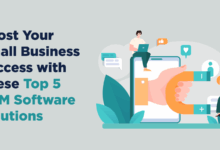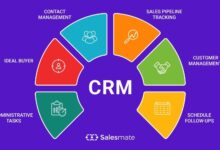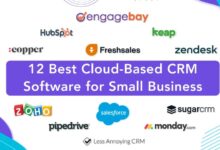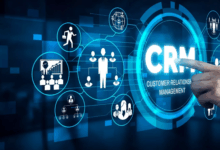Best Enterprise CRM Solutions: A Comprehensive Guide
Best Enterprise CRM Solutions are crucial for large organizations seeking to streamline operations and enhance customer relationships. This guide delves into the critical aspects of selecting, implementing, and utilizing enterprise-level CRM systems, examining key features, leading platforms, and future trends. We’ll explore how these systems drive efficiency, improve data analysis, and ultimately contribute to significant business growth.
From defining the criteria for selecting the “best” solution to navigating the complexities of implementation and integration, we aim to provide a clear and insightful understanding of the entire CRM landscape for enterprises. We’ll compare different deployment models, highlight essential features, and showcase real-world examples of successful CRM implementations across various industries.
Defining “Best” Enterprise CRM Solutions
Selecting the “best” enterprise CRM solution isn’t about picking a single, universally superior system. Instead, it’s about identifying the system that most effectively aligns with a specific organization’s unique needs, goals, and operational context. The ideal CRM solution maximizes efficiency, improves customer relationships, and ultimately contributes to increased profitability.
Criteria for Evaluating Enterprise CRM Effectiveness
Effective evaluation necessitates a multifaceted approach, considering factors beyond mere feature lists. Crucial aspects include the CRM’s scalability to accommodate future growth, its seamless integration with existing enterprise systems (ERP, marketing automation, etc.), and the overall user experience for both employees and customers. A robust security framework is paramount, protecting sensitive customer data. Furthermore, the vendor’s reputation for reliability, support, and ongoing innovation should be carefully assessed. Finally, the total cost of ownership (TCO), encompassing licensing fees, implementation costs, training, and ongoing maintenance, needs thorough examination.
Key Performance Indicators (KPIs) for Measuring CRM Success
Several key performance indicators (KPIs) provide quantifiable measures of CRM effectiveness. These metrics help organizations track progress, identify areas for improvement, and demonstrate the return on investment (ROI) of their CRM implementation. Common KPIs include customer acquisition cost (CAC), customer lifetime value (CLTV), customer churn rate, sales conversion rates, average revenue per user (ARPU), and customer satisfaction (CSAT) scores. Tracking these metrics allows for data-driven decision-making and continuous optimization of CRM strategies. For example, a decrease in customer churn rate alongside an increase in CLTV would clearly indicate a successful CRM implementation.
Business Needs Influencing CRM System Choice
The choice of CRM system is heavily influenced by the specific business needs of the organization. A large multinational corporation with diverse product lines and a global customer base will require a vastly different system than a small, locally-focused business. For instance, a company prioritizing sales automation might choose a CRM with strong sales force automation (SFA) capabilities, while a company focused on customer service might prioritize a system with robust case management and ticketing features. Similarly, a business with a large volume of customer interactions might require a system with advanced reporting and analytics capabilities to effectively manage and analyze customer data. A company with a strong emphasis on marketing automation might prioritize CRM systems with integrated marketing tools.
On-Premise vs. Cloud-Based CRM Deployment Models
Enterprises face a significant choice between on-premise and cloud-based CRM deployments. On-premise systems are installed and maintained on the organization’s own servers, offering greater control over data security and customization but demanding significant upfront investment in hardware, software, and IT personnel. Cloud-based CRM solutions, on the other hand, are hosted by a third-party provider, eliminating the need for significant on-site infrastructure and offering scalability and accessibility advantages. The choice often hinges on factors like budget, IT infrastructure capabilities, security requirements, and the level of customization needed. Larger enterprises with complex IT landscapes and stringent security requirements might opt for on-premise solutions, while smaller businesses or those seeking rapid deployment and cost-effectiveness might favor cloud-based options. Many organizations now utilize hybrid models, combining elements of both approaches to optimize their CRM infrastructure.
Top Enterprise CRM Features
Choosing the right enterprise CRM involves understanding its core functionalities. Several key features differentiate leading solutions from basic contact management systems. These features are crucial for maximizing efficiency, improving customer relationships, and driving overall business growth. The following sections delve into the essential capabilities that define a top-tier enterprise CRM.
Essential Features of Leading Enterprise CRM Solutions
Five essential features consistently found in leading enterprise CRM solutions are: comprehensive contact management, robust sales force automation, streamlined marketing automation, detailed customer service management, and advanced reporting and analytics. These features work in synergy to provide a holistic view of customer interactions and business performance. Each contributes significantly to improved operational efficiency and strategic decision-making.
Integration Capabilities with Other Business Systems
Seamless integration with other business systems is paramount for an enterprise CRM’s success. A siloed CRM system, isolated from other crucial business applications like ERP (Enterprise Resource Planning), marketing automation platforms, and e-commerce systems, significantly limits its effectiveness. Effective integration allows for a unified view of customer data, automating workflows, eliminating data redundancy, and improving data accuracy. For example, integrating a CRM with an ERP system can automate order processing, inventory management, and billing, streamlining the entire customer lifecycle. This integration minimizes manual data entry, reduces errors, and provides a single source of truth for all customer-related information.
Benefits of Advanced Analytics and Reporting Functionalities
Advanced analytics and reporting are not merely supplementary features; they are the engines driving data-driven decision-making within an enterprise CRM. These functionalities transform raw data into actionable insights, revealing trends, patterns, and areas for improvement. For instance, analyzing sales data can identify top-performing products, pinpoint areas needing improvement in sales processes, and help forecast future sales accurately. Similarly, analyzing customer service interactions can identify recurring issues, measure customer satisfaction, and improve service delivery. This data-driven approach enables proactive strategies, optimizing resource allocation, and maximizing ROI.
Comparison of Three Popular Enterprise CRM Platforms
| Feature | Salesforce Sales Cloud | Microsoft Dynamics 365 | SAP CRM |
|---|---|---|---|
| Contact Management | Highly customizable, robust contact management with advanced features like segmentation and lead scoring. | Comprehensive contact management with strong integration with other Microsoft products. | Robust contact management capabilities, tightly integrated within the SAP ecosystem. |
| Sales Force Automation | Strong sales automation tools including opportunity management, forecasting, and pipeline analysis. | Comprehensive sales automation with features such as lead management, opportunity tracking, and sales forecasting. | Provides robust sales force automation tools focused on sales process optimization and reporting. |
| Marketing Automation | Offers integrated marketing automation capabilities including email marketing, campaign management, and lead nurturing. | Provides marketing automation features including email marketing, social media integration, and campaign management. | Offers marketing automation features within the broader SAP marketing cloud suite. |
| Customer Service Management | Robust customer service features including case management, knowledge base integration, and self-service portals. | Comprehensive customer service management with features like case management, service level agreements (SLAs), and omnichannel support. | Offers strong customer service management features integrated with other SAP modules. |
Specific Enterprise CRM Solutions
Choosing the right enterprise CRM solution requires careful consideration of various factors, including business needs, budget, and technical capabilities. This section delves into three leading platforms, providing a detailed comparison to aid in informed decision-making. We will examine their features, pricing models, and respective strengths and weaknesses.
Salesforce
Salesforce is a widely recognized and established leader in the CRM market. It offers a comprehensive suite of applications designed for various business needs, from sales and marketing to customer service and commerce. Its modular design allows businesses to select and integrate only the features they require, scaling as their needs evolve. Salesforce boasts a vast ecosystem of third-party integrations and a large, active community providing ample support and resources.
Microsoft Dynamics 365
Microsoft Dynamics 365 is a robust CRM platform deeply integrated with the Microsoft ecosystem. This integration offers seamless compatibility with other Microsoft products like Office 365, SharePoint, and Power BI, streamlining workflows and data management. Dynamics 365 offers a range of functionalities similar to Salesforce, focusing on sales, marketing, customer service, and operations. Its strength lies in its ease of use for businesses already invested in the Microsoft environment.
SAP CRM
SAP CRM, part of the broader SAP Business Suite, is a powerful enterprise CRM solution particularly well-suited for large, complex organizations. It emphasizes integration with other SAP applications, creating a holistic enterprise resource planning (ERP) system. SAP CRM excels in handling vast amounts of data and managing intricate business processes. Its comprehensive functionality caters to specific industry needs and offers advanced analytics capabilities.
Pricing Models Comparison
The pricing models for these three platforms vary significantly and are often customized based on the number of users, features selected, and required support levels. Generally, Salesforce operates on a subscription-based model, with pricing tiered based on the chosen edition and features. Microsoft Dynamics 365 also uses a subscription model, offering different plans with varying levels of functionality. SAP CRM typically employs a more complex pricing structure, often involving licensing fees, implementation costs, and ongoing maintenance charges. Direct comparisons of specific pricing are difficult without knowing the precise configuration requirements for each business. However, it’s safe to say that all three platforms can range from relatively affordable options for small teams to very substantial costs for large enterprises with complex deployments.
Pros and Cons of Each Platform
Understanding the advantages and disadvantages of each platform is crucial for selecting the best fit.
Below is a summary of the pros and cons:
| Platform Name | Pricing | Pros | Cons |
|---|---|---|---|
| Salesforce | Subscription-based, tiered pricing |
|
|
| Microsoft Dynamics 365 | Subscription-based, tiered pricing |
|
|
| SAP CRM | Licensing fees, implementation costs, ongoing maintenance |
|
|
Implementation and Integration Considerations
Successfully implementing an enterprise CRM system requires careful planning and execution. A phased approach, focusing on clear objectives and robust change management, is crucial for minimizing disruption and maximizing return on investment. Ignoring these considerations can lead to project delays, budget overruns, and ultimately, user dissatisfaction and system failure.
Key Steps in Enterprise CRM System Implementation
Implementing a new enterprise CRM system involves a series of interconnected steps. A well-defined project plan, with clear timelines and responsibilities, is essential for successful execution. Each phase builds upon the previous one, ensuring a smooth transition to the new system.
- Needs Assessment and Requirements Gathering: This initial phase involves identifying the organization’s specific needs and requirements for a CRM system. This includes defining key performance indicators (KPIs), identifying user roles and access levels, and outlining the desired functionalities.
- Vendor Selection and System Selection: Once requirements are defined, the organization can begin evaluating potential CRM vendors and solutions. This involves comparing features, pricing, and vendor support capabilities.
- Data Migration Planning and Execution: Migrating existing customer data to the new CRM system is a critical step. This requires careful planning to ensure data accuracy, consistency, and completeness.
- System Customization and Configuration: The CRM system may need to be customized to meet the organization’s specific needs. This often involves configuring workflows, dashboards, and reports.
- Testing and Quality Assurance: Thorough testing is essential to identify and resolve any issues before the system goes live. This includes unit testing, integration testing, and user acceptance testing (UAT).
- Deployment and Go-Live: The final step involves deploying the CRM system to end-users. This may involve a phased rollout or a big-bang approach, depending on the organization’s needs.
- Post-Implementation Support and Maintenance: Ongoing support and maintenance are crucial for ensuring the long-term success of the CRM system. This includes addressing user issues, providing training, and performing regular system updates.
Best Practices for Data Migration During CRM Implementation
Data migration is a complex process that requires careful planning and execution. Inaccurate or incomplete data can severely compromise the effectiveness of the new CRM system. Best practices include:
- Data Cleansing and Validation: Before migrating data, it’s crucial to cleanse and validate it to ensure accuracy and consistency. This may involve removing duplicates, correcting errors, and standardizing data formats.
- Data Mapping: A detailed data mapping exercise is necessary to define how data will be transformed and mapped from the legacy system to the new CRM system.
- Phased Migration Approach: Migrating data in phases can help to minimize disruption and allow for easier troubleshooting. This approach allows for testing and validation at each stage.
- Data Backup and Recovery Plan: A robust backup and recovery plan is essential in case of data loss or corruption during the migration process.
- Post-Migration Data Validation: After the migration is complete, it’s crucial to validate the data to ensure its accuracy and completeness. This may involve comparing the data in the new CRM system to the legacy system.
Challenges of Integrating a CRM System with Existing Enterprise Applications
Integrating a CRM system with existing enterprise applications can present significant challenges. These challenges often stem from differences in data structures, formats, and APIs. Careful planning and a phased approach are crucial for successful integration.
For example, integrating a CRM system with an ERP system might require mapping customer data between the two systems, ensuring consistent data across both platforms. This process can be complex, requiring significant technical expertise and potentially custom development.
Importance of User Training and Adoption Strategies for Successful CRM Implementation
User adoption is a critical factor in the success of any CRM implementation. Without proper training and support, users may be hesitant to adopt the new system, leading to low utilization and a poor return on investment.
Effective training programs should be tailored to the specific needs and roles of different user groups. They should cover the key features and functionalities of the CRM system, as well as best practices for using the system effectively. Ongoing support and readily available resources are also essential for ensuring continued user engagement and successful system adoption. Furthermore, change management strategies, including clear communication and addressing user concerns, are paramount for facilitating a smooth transition and encouraging user buy-in.
Future Trends in Enterprise CRM
The enterprise CRM landscape is in constant evolution, driven by technological advancements and changing business needs. Understanding emerging trends is crucial for businesses seeking to leverage CRM for optimal efficiency and competitive advantage. This section explores key trends shaping the future of enterprise CRM.
Emerging Trends in Enterprise CRM Technology
Three significant trends are reshaping the enterprise CRM space: the rise of AI-powered CRM, the increasing importance of data-driven decision making, and the growing adoption of cloud-based CRM solutions. AI is transforming how businesses interact with their customers, while advanced analytics empower more strategic decision-making. Cloud-based solutions offer scalability, flexibility, and cost-effectiveness, making them increasingly attractive to organizations of all sizes.
The Impact of Artificial Intelligence on CRM Functionality
Artificial intelligence is revolutionizing CRM functionality by automating tasks, personalizing customer experiences, and providing valuable insights. AI-powered CRM systems can automate routine tasks such as lead scoring, data entry, and customer segmentation, freeing up human agents to focus on more complex and strategic activities. Predictive analytics, driven by AI, allows businesses to anticipate customer needs and proactively address potential issues. For example, an AI-powered CRM system might predict which customers are likely to churn and trigger automated interventions to retain them. Furthermore, AI enables personalized customer interactions through chatbots and recommendation engines, enhancing customer satisfaction and loyalty. This leads to improved customer engagement and increased sales conversion rates.
Automation’s Transformation of Enterprise CRM Workflows
Automation is streamlining and optimizing enterprise CRM workflows, significantly improving efficiency and productivity. Automated workflows can handle tasks such as lead qualification, appointment scheduling, and follow-up communications, reducing manual effort and human error. For instance, an automated workflow might automatically route leads to the appropriate sales representative based on predefined criteria such as industry, location, or company size. This ensures that leads are handled efficiently and promptly, maximizing conversion opportunities. Furthermore, automation facilitates the integration of various business systems, creating a seamless flow of information across departments. This integrated approach eliminates data silos and ensures consistent customer experiences across all touchpoints.
Integrating CRM with Emerging Technologies: IoT and Blockchain
Integrating CRM with emerging technologies like the Internet of Things (IoT) and blockchain offers significant potential benefits. IoT devices generate vast amounts of data about customer behavior and preferences, which can be integrated into CRM systems to create highly personalized customer profiles. For example, a smart home device might provide data on a customer’s energy consumption habits, which a CRM system could use to tailor marketing messages or offer relevant product recommendations. Blockchain technology, with its inherent security and transparency, can enhance data security and improve trust in CRM data. By using blockchain to secure customer data, businesses can enhance customer privacy and compliance with data protection regulations. This improved security and transparency can build stronger customer relationships, fostering greater trust and loyalty.
Illustrative Examples
Real-world applications highlight the transformative power of enterprise CRM systems across diverse industries. Examining specific examples demonstrates how these solutions enhance customer relationships, streamline operations, and drive significant business improvements.
Manufacturing Company CRM Implementation
A large multinational manufacturing company, specializing in heavy machinery, implemented a comprehensive CRM system to manage its extensive customer base, encompassing distributors, original equipment manufacturers (OEMs), and end-users. The CRM integrates with their enterprise resource planning (ERP) system, providing real-time visibility into order status, inventory levels, and production schedules. This integration allows for proactive communication with customers regarding delivery timelines, potential delays, and proactive maintenance scheduling. Sales teams leverage the CRM’s detailed customer history and interaction logs to personalize communications, identify upselling opportunities, and anticipate future needs. Service technicians use the mobile CRM application to access service history, schematics, and parts inventory, enabling faster on-site repairs and improved customer satisfaction. The improved data visibility and streamlined communication facilitated by the CRM have resulted in reduced lead times, improved customer retention, and increased overall production efficiency.
Global Financial Institution CRM Deployment
A leading global financial institution employs a robust CRM system to manage its diverse customer portfolio, encompassing retail banking, wealth management, and corporate services. The CRM is configured to adhere to stringent regulatory compliance requirements, including data privacy regulations like GDPR and CCPA. The system incorporates comprehensive audit trails, access controls, and data encryption to ensure data security and regulatory compliance. Customer relationship managers use the CRM to track client interactions, manage financial portfolios, and identify cross-selling opportunities while maintaining a complete audit trail of all communications and transactions. The institution leverages the CRM’s reporting and analytics capabilities to identify trends, assess risk, and comply with reporting requirements for regulatory bodies. The centralized customer data repository within the CRM streamlines onboarding processes, reduces operational costs, and minimizes the risk of compliance violations. Furthermore, the system’s advanced analytics capabilities enable the institution to personalize customer service and offer tailored financial products.
Customer Interaction Workflow Across Departments
Imagine a visual representation of a customer interaction flowing across various enterprise departments. The process begins with a customer inquiry received via email or phone by the customer service department. This inquiry is logged into the CRM, automatically assigning it a unique identifier and routing it to the appropriate team based on predefined rules. The customer service representative updates the CRM with details of the interaction and any necessary actions. If the inquiry requires technical support, the CRM automatically escalates the issue to the technical support team, providing them with complete context from the initial interaction. Once resolved, the technical support team updates the CRM with the resolution, which is then reflected in the customer’s history. The sales team can access this interaction history to identify opportunities for upselling or cross-selling relevant products or services. Finally, the CRM generates automated follow-up communications to ensure customer satisfaction and gather feedback. This entire workflow is visible across all relevant departments, ensuring seamless collaboration and efficient issue resolution. The visual representation would be a flowchart, clearly showing the path of the customer interaction through each department, with the CRM acting as the central hub connecting all these departments.
Final Conclusion
Ultimately, the selection of the best enterprise CRM solution hinges on a thorough understanding of specific business needs and a strategic approach to implementation. By carefully considering the factors discussed—from key performance indicators and feature sets to integration challenges and future trends—organizations can make informed decisions that maximize the value of their CRM investment and foster lasting customer relationships. Successful CRM adoption requires not only the right technology but also a commitment to user training and ongoing optimization.





